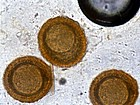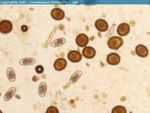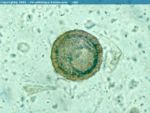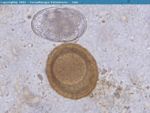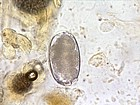Category:Horse Nematodes
Gastrointestinal Nematodes
Introduction
Many nematode species occur in the equine gastrointestinal tract, although not all are of equal importance:
| Stomach | Small Intestine | Large Intestine |
|---|---|---|
|
|
|
Strongyles (Red worms)
The strongyles that occur in the horse can be divided on the basis of size into two groups
- Large strongyles
- Strongylus species (3 species; used to be widespread prior to the introduction of worm control programmes; now uncommon)
- Triodontophorus species (common)
- Small strongyles
- Also known as Cyathostomins (preferred term), cyathostomes, trichonemes or small redworms
- Cyathostomins (widespread, including 4 genera and over 40 species of worms)
Large strongyles
Morphology
Gross
- Stout worms, 1.5-5cm long
- Large buccal capsule
- Bursa visible to the naked eye (male worms only)
Microscopic (buccal capsule)
- Double row of leaf crowns
- Teeth (0, 2, 3 or more)
- Dorsal gutter (channel for secretions)
Life-cycle
Infection with all three Strongylus species and Triodontophorus is by ingestion of infective stage larvae (L3) at grazing. Larvae pass down the intestinal tract and penetrate the intestinal mucosa at which point there are important species differences in life-cycle.
Pathogenicity
Adult Worms:
- Plug feeders
- Strongylus species:
- Large buccal capsule
- Penetrate right down to the muscularis layer and blood vessels
- Leaves small circular bleeding ulcers → anaemia if present in large numbers
- Triodontophorus:
- Smaller buccal capsule
- More superficial damage
- May feed in "herds", leaving large ulcers, several centimetres across
- Ulcers heal and leave scars
Pathogenesis of infection with Strongylus species larvae:
- S. vulgaris:
- Potentially highly pathogenic
- Damage to cranial mesenteric artery → endarteritis → thrombosis and possibly embolism → colic
- Other Strongylus species :
- Relatively non-pathogenic
- Migration of S. edentatus and S. equinus confined to roomy tissues (e.g. mesentery, liver)
Verminous endarteritis
- Caused by larvae of S. vulgaris within the cranial mesenteric artery
- Also called "verminous aneurism" (misnomer as aneurism = dilatation/thinning of blood vessel wall; also, aneurisms are rare)
- Wall of artery grossly thickened (organising thrombi, inflammatory responses)
- Can be detected on rectal palpation
- Many cases asymptomatic
- May get embolism → infarction of areas of intestinal wall → colic or chronic ulceration (note: generally good collateral circulation; therefore colic is not inevitable)
- Aberrant larvae may cause thrombosis in other arteries; e.g. iliac, cerebral, coronary
- Avermectin/milbemycins or fenbendazole are used to control migrating S. vulgaris larvae
Small strongyles (Cyathostomins)
Morphology
Gross:
- Small worms, <1.5cm long
- Small, shallow buccal capsule
Microscopic:
- Buccal capsule shape
- Double row of leaf crowns
- Teeth may be present
Life-cycle
- Infection by ingestion of L3
- Larvae invade mucosa of large intestine
- Larvae may develop to L4 without interruption
- Cyathostomin larvae can arrest at EL3 stage
- L4 emerge into gut lumen and mature to adult worms
- Prepatent period 8-12 weeks (depending on species)
Pathogenicity
General:
- Adult and larval worms are plug feeders, restricting the damage to more superficial mucosa
Cyathostominosis:
- Initial infection (L3) → local inflammatory response
- Developing L4s can be seen as brown flecks in the mucosa
- They can be present in very large numbers (→ the so-called "pepper-pot lesion")
- Larval emergence throughout summer/autumn and plug-feeding of adults → major contributor to the "wormy" horse:
- Unthriftiness
- Poor coat
- Anaemia
- Diarrhoea)
- May be tens or hundreds of thousands of adults and millions of mucosal larvae present
- Emergence of massive numbers of previously arrested larvae in late winter/early spring → massive inflammatory infiltration → serious disease characterised by severe diarrhoea and/or weight loss (larval or Type 2 cyathostominosis)
General epidemiology of large and small strongyles
Strongylosis occurs in
- Young horses
- Adult animals (especially if overcrowding, poor hygiene)
- Animals on permanent pasture
Sources of infection
- Overwintered L3 on pasture
- Many adult horses pass significant numbers of strongyle eggs throughout their lives
- "Spring rise" in faecal egg output occurs in both breeding and non-breeding horses
Pattern of infection on pasture
- Pattern of L3 on pasture is similar to gastrointestinal worms in cattle
- Main difference is that the mare makes a major contribution to pasture contamination (c.f. cow)
Hypobiosis of cyathostomin larvae
- Occurs throughout the year, but particularly in late summer/autumn
- EL3 may remain arrested for years
- Resumption of normal development can occur
- seasonally in late winter/early spring
- following removal of adult worm population via anthelmintic treatment
Larval cyathostominosis
- Sudden onset diarrhoea and/or weight-loss
- Diagnosis difficult, prognosis guarded
- Generally in late winter/spring
- Usually <5 years old
- Sporadic, but increasing in incidence
- Hyperglobulinaemia, especially IgG(T)
- Hypoalbuminaemia
- Leukocytosis
- Sometimes peripheral oedema
- Faecal egg-count low (disease caused by emerging larvae)
- Larvae may be found in faeces or on faecal glove
Pathogenesis
Resumed development of massive numbers of larvae → subsequent emergence of bright red L4 → massive eosinophilic infiltration of mucosa → catarrhal and haemorrhagic colitis
Control of cyathostomin infections in horses
Anthelmintics
- Only 3 chemical groups currently available
- Avermectin/milbemycins
- Benzimidazoles
- Pyrantel
- Resistance is an emerging problem (especially to benzimidazoles)
Target life-cycle stages
- These are not all equally susceptible to each anthelmintic
- Pyrantel is affective against
- Adult worms in the lumen
- Ivermectin or a one off administration of Fenbendazole is affective against
- Adult worms and L4 in the lumen
- Moxidectin or a 5 day course of Fenbendazole is affective against
- Adult worms and L4 in the lumen
- Developing and hypobiotic L3 in the mucosa
Egg reappearance period
- This is the time from treatment until eggs reappear in the faeces. It is determined by
- degree of activity against mucosal larval stages
- persistency of anthelmintic treatment
Prevention of pasture contamination
- The objective is to create safe grazing by preventing depostion of strongyle eggs onto pasture
- Treat all grazing horses at intervals determined by
- Egg reappearance time of chosen anthelmintic
- Risk level
- Treat all new arrivals and stable for 48-72 hours so that eggs are not passed onto pasture
- Adopt strategy that will minimise risk of resistance developing (you may need to include tapeworm and stomach bots in your scheme)
- No new eggs passed → no new L3 developing, however it is important to use epidemiological knowledge to predict how long existing L3 will survive as the pasture will not be safe for use before then
- Remove faeces from paddocks at least weekly:
- This markedly reduces dependence on anthelmintics
- Increases available grazing
- But is labour intensive and less effective in rainy weather
- Examine faecal samples twice yearly to monitor effectiveness of your chosen strategy
Pasture management
- Reserve clean grazing for nursing mares and foals
- Rest pastures used the previous year until overwintered L3 have gone
- Mixed or alternate grazing with cattle or sheep
- These are refractory to most horse worms, except T.axei
Chemoprophylaxis of larval cyathostominosis
- Needed if a horse is known to have grazed heavily contaminated pasture and may therefore be harbouring massive numbers of hypobiotic larvae
- Fenbendazole treatment given daily for 5 consecutive days in autumn or winter will reduce the risk of clinical disease developing.
Pages in category "Horse Nematodes"
The following 16 pages are in this category, out of 16 total.
